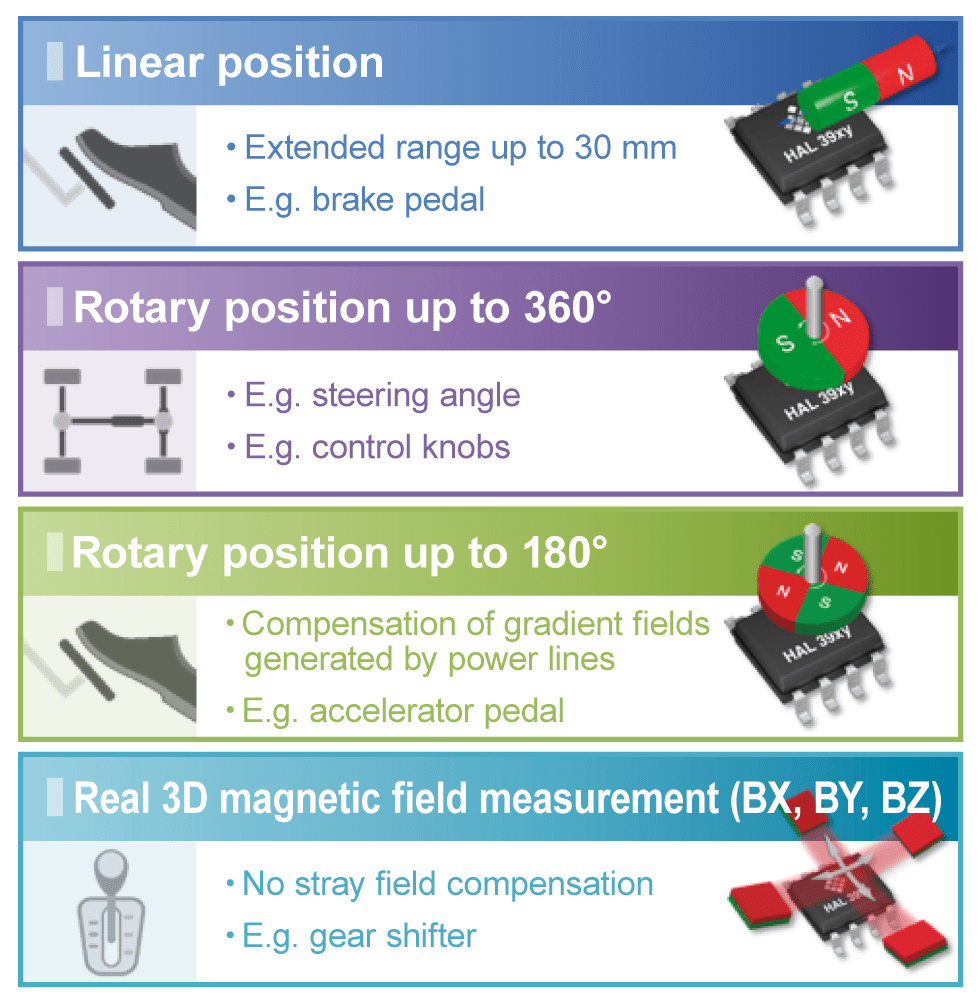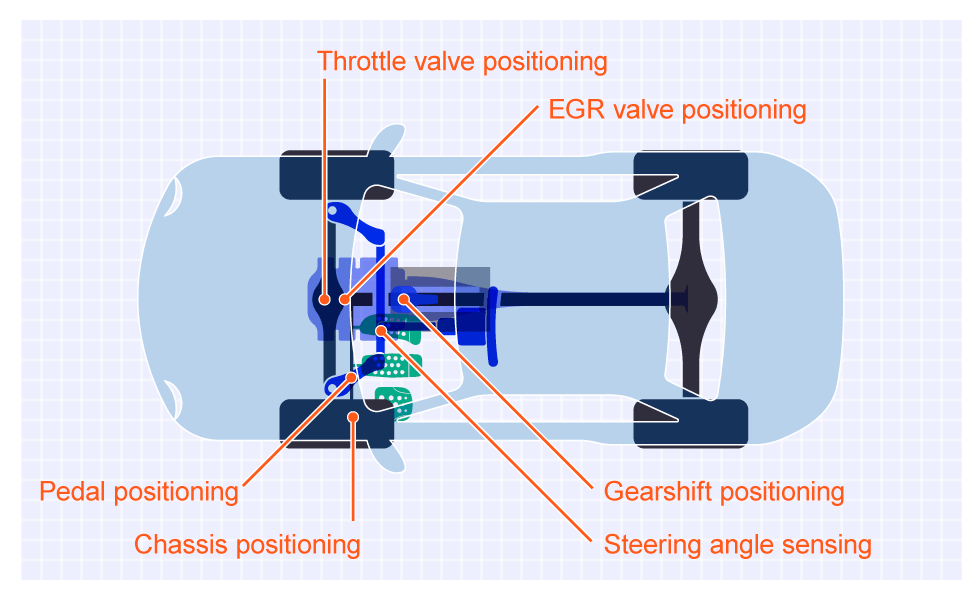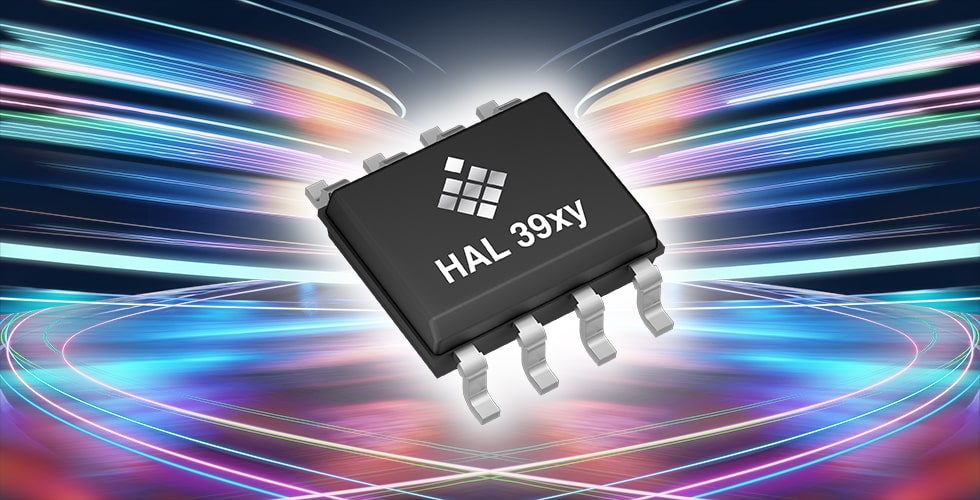A 3D Magnetic Sensor Immune to Magnetic Interference Enables Autonomous Vehicles to Turn Safely
The Technological Challenges of Steering of an Autonomous Vehicle
In an effort to bring autonomous vehicles to life and advance them even further, automotive manufacturers around the world are aggressively pursuing development, partnerships, and fund-raising. Real-world trials and robotic taxi services are already under way in numerous countries. Nevertheless, autonomous vehicles still face diverse technological challenges. Among the fundamentals of an automobile—running, turning, and stopping—turning, achieved through steering, a system for changing the direction of travel, is an area that is particularly in need of technological development.
In general, the steering system of an automobile is a mechanism that changes the direction of the tires based on the amount the steering wheel*1 is rotated. A power steering system assists the driver by allowing the tires to be turned with a light touch, and is a crucial function for the turning an automobile. Power steering systems were largely hydraulic in the past, but they are being replaced by electric power steering (EPS*2) systems in recent years, mainly due to advantages in fuel efficiency.
Global demand projection for electric power steering systems by volume

Source: Electric Power Steering Systems Market 2017 by Yano Research Institute Ltd., October 13, 2017.
Note: Based on aggregate shipments of EPS and EHPS systems
Because EPS systems are powered by electric motors, they can easily be controlled electronically and can steer vehicles without driver input, and are therefore said to be well-suited for autonomous driving in the future. To make that happen, sensors that detect the steering angle are critical. The detected angle data can be utilized in applications such as parking assistance systems that feature automated steering and electronic stability control (ESC) systems, thereby contributing to the realization of autonomous driving.
A High-Performance 3D Hall Sensor Solution Featuring Four measurement modes on a single chip
Due to safety, comfort, and energy efficiency considerations, position detection in automobiles, including steering angle detection, is generally achieved using magnetic sensors that determine the position or rotation of targets by measuring strengths or changes in magnetic fields. TDK offers the HAL 39xy 3D Hall sensor, which adheres to the ISO 26262 safety standards for autonomous vehicles, and has excellent functionality and flexibility.
A 3D Hall sensor utilizes the galvanomagnetic phenomenon called the Hall effect to measure magnetic fields in the x-, y-, and z-axes, enabling the detection of linear movements as well as magnetic field rotations. The HAL 39xy is the only magnetic sensor that offers the following four measurement modes on a single chip: 1. Linear position, 2. Rotational position up to 360°, 3. Rotational position up to 180°, and 4. 3D measurement. It not only features low power consumption, but supports a variety of the latest digital interfaces*3 including SENT/PSI5 and Short PWM Code (SPC), and has already been adopted in steering angle detection systems for autonomous vehicles.
Another major feature of the sensor is its built-in ability to compensate for stray magnetic fields*4. With automobiles becoming increasingly computerized and electrified, interference from a variety of magnetic fields has been a rising issue, but the HAL 39xy has solved this challenge with a revolutionary technology: by equipping the sensor itself with compensation functions.
Additionally, the compact and lightweight HAL 39xy is expected to be utilized in solutions such as steering angle detection in steer-by-wire systems, which are currently under development for practical use and is expected to be a natural fit with advanced autonomous driving. Steer-by-wire removes the mechanical connection between the driver-controlled steering wheel and the turning of the tires, relying instead on electric signals to achieve steering. Furthermore, the HAL 39xy can contribute to even more by-wire systems, ranging from brake-by-wire to shift-by-wire.
The HAL 39xy is a product developed by TDK-Micronas, a TDK group company. Based in Freiburg, in southwest Germany, TDK-Micronas has pioneered the development, design, and manufacture of Hall sensors for more than 30 years, and has shipped over 5 billion sensors for automotive and industrial applications.
 Jens Schubert
Jens SchubertProduct Marketing Manager, Magnetic Sensors
TDK-Micronas GmbH
Jens Schubert, Product Marketing Manager, explains why the company was successful in developing the HAL 39xy: “A key strength of TDK-Micronas is complementary metal-oxide semiconductor (CMOS) technology, which is now mainstream in the large-scale integration (LSI) manufacturing process. This was made possible by our expertise with signal processing accumulated over more than 30 years, and the development of a unique production facility.”
The 3D Hall sensor HAL 39xy, a low-power position sensor with 2D/3D detection functions, suitable for a variety of applications including the position detection of pedals, valves, and gear shifters. For details, please visit the Product Center.
Terminology
- Steering system: A system that changes the angle of the front wheels/tires, thereby turning the automobile. Some automobiles adopt four-wheel steering systems that turn all wheels.
- Electric power steering (EPS) system: A system that uses electricity (electric motors) to assist steering.
- Digital interface: Digital communication standards for in-vehicle networks.
- Stray magnetic field: External magnetic interference that affects the normal operation of various devices.




